Do you have a question about the Yamaha WOLVERINE YFM350FXR and is the answer not in the manual?
Critical safety points before operating the ATV.
Defines WARNING, CAUTION, and NOTE symbols used in the manual.
Details warnings about tire pressure, overloading, and safe riding practices.
Advises on age limits for operation and prohibits carrying passengers.
General safety guidelines for ATV operation, including training and precautions.
Essential practices for safe operation, including terrain, speed, and control.
Guidance on safely climbing, descending, and crossing hills and slopes.
Advice on riding over rough terrain and through shallow water.
Information on proper loading techniques and the impact of accessories.
Safety precautions for refueling and operating in areas with exhaust fumes.
Reinforces that the ATV is for off-road use only and prohibits paved surfaces.
Strictly prohibits operating the ATV on public streets, roads, or highways.
Guidelines for riding cautiously on unfamiliar terrain and slippery surfaces.
Recommends caution flags for visibility and prohibits riding in no-trespassing areas.
Instructions for recording key identification numbers for parts ordering and reference.
Explains the location and purpose of key and vehicle identification numbers.
Details the location and importance of the model label for parts ordering.
Details the functions of the ON and OFF positions of the main switch.
Identifies and explains the meaning of various indicator and warning lights.
Provides a procedure to check the functionality of the oil temperature warning light.
Explains the function of the light switch, engine stop switch, and start switch.
Describes how to use and check the throttle lever for smooth operation.
Explains the function and adjustment of the speed limiter for rider experience.
Details the operation of the front brake lever and rear brake pedal/lever.
Explains how to apply and release the parking brake for safety.
Describes the operation of the shift pedal and reverse knob for gear selection.
Instructions on how to use the recoil starter to start the engine.
Explains the function and operation of the fuel tank cap and fuel cock.
Details how to use the starter (choke) for cold engine starting.
Provides instructions on how to remove and install the seat.
Specifies the load limit for the storage box and related cautions.
Explains how to adjust spring preload for comfort and handling.
Detailed checks for brakes, fluid level, and leakage.
Procedures for checking fuel and engine oil levels.
Instructions for checking tire pressure, wear, and wheel fittings.
Verifying the proper operation of lights and switches.
Procedure for checking and replenishing battery fluid.
How to check brake pad wear using indicators.
Procedure for checking and maintaining the brake fluid level.
How to identify and address brake fluid leaks.
How to test brake performance after starting.
Guidelines on using gasohol and handling fuel safely during refueling.
Specifies oil types, grades, and classifications for the engine.
States the required oil volume for periodic changes and filter replacement.
Specifies recommended, minimum, and maximum tire pressures for safe operation.
Instructions on setting tire pressures when cold and ensuring equality.
Detailed steps for starting the engine in cold weather conditions.
Stresses the importance of understanding all controls before riding.
Warning about freezing control cables in cold weather and how to avoid it.
Ensures the neutral light functions correctly when the transmission is in neutral.
Notes that the engine can start in any gear if the rear brake is applied.
Guides on selecting the correct choke position based on ambient temperature.
Troubleshooting steps if the engine fails to start after multiple attempts.
How to use the recoil starter if the battery is discharged.
Guidance on adjusting the choke position for proper engine warm-up.
Warning to stop the machine and close throttle before shifting gears to prevent damage.
Procedure to shift the transmission into neutral.
Cautions regarding coasting and towing the machine.
Emphasizes proper coordination of throttle and shift pedal to avoid wheelies.
Warning against downshifting at excessive engine speeds to prevent accidents.
Recommendations for the first 10 hours of engine break-in.
Recommendations for the break-in period between 10 and 20 hours.
Guidance on selecting appropriate and safe accessories for the ATV.
Specifies vehicle, storage box, and trailer hitch weight limits.
Highlights the importance of reading the manual and safety labels.
Recommends certified training for beginners and experienced riders.
Lists essential apparel like helmets, gloves, boots, and long-sleeved shirts.
Emphasizes checking tires and performing regular maintenance.
Emphasizes coordinating throttle and brake for smooth acceleration and turning.
Stresses practicing turning at low speeds before attempting higher speeds.
Warns about the increased risk of overturns on steep hills.
Procedures and cautions for climbing hills safely.
Advice on crossing slopes and turning maneuvers on hills.
Cautions about braking and traction on slippery surfaces when descending hills.
Proper body positioning and steering adjustments for traversing slopes.
Emphasizes testing brakes after riding through water.
Instructions for draining water and cleaning the ATV after water exposure.
Advice on checking for obstacles and navigating them safely.
How to regain control when the ATV slides sideways.
Warns against losing control on extremely slippery surfaces like ice.
How to maintain balance and regain control on slopes.
Procedures for riding through shallow water and checking brakes.
Recommends keeping the manual and tool kit accessible for maintenance.
Explains the scope of service information and the need for a torque wrench.
Warns against improper modifications affecting handling and safety.
Procedures for checking and adjusting valves and spark plugs.
Maintenance for carburetor, breather system, and exhaust system.
Inspection of fuel lines and engine oil levels.
Checks for wheels, bearings, steering system, and drive shaft lubrication.
Inspection of axle boots and chassis fittings for tightness.
Steps for checking battery specific gravity and breather hose.
How to measure and adjust the spark plug electrode gap.
Instructions for washing and drying the air filter element with solvent.
How to reinstall the air filter element and check for proper seals.
How to adjust the engine's idling speed using the throttle stop screw.
Steps for removing, storing, and recharging the battery.
Diagnosing issues related to fuel supply and the fuel cock.
Steps to check for engine compression problems.
Procedures for checking spark plug and ignition system.
Step-by-step instructions for washing and drying the ATV.
How to clean the seat and apply wax to painted surfaces.
Warning about reduced stopping ability with wet brakes after washing.
Instructions for adding fuel stabilizer and conditioner.
Steps to protect the engine during storage, including oiling cylinder walls.
Provides overall dimensions, seat height, wheel base, and weight.
Details engine type, displacement, bore, stroke, and compression ratio.
Recommended oil types, classifications, and quantities for the engine.
Specs for final gear oil, differential gear oil, and air filter type.
Details on fuel type, tank capacity, and carburetor model.
Specs for transmission type, gear ratios, frame, and suspension.
Tire type and size, and brake system details.
Details on front/rear suspension and wheel travel.
Specs for ignition, generator, battery, and lighting components.
Details the owner's obligations for maintaining warranty coverage.
| Brand | Yamaha |
|---|---|
| Model | WOLVERINE YFM350FXR |
| Category | Offroad Vehicle |
| Language | English |
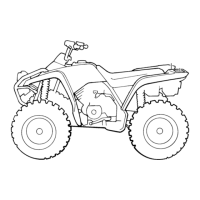
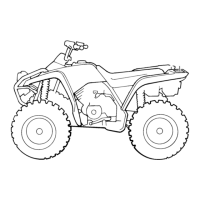
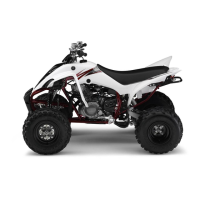



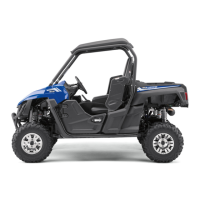

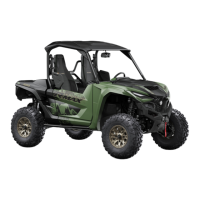

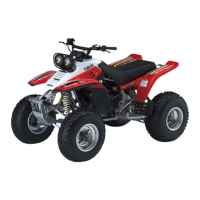
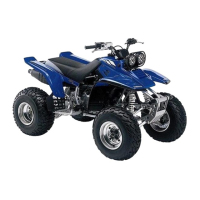
